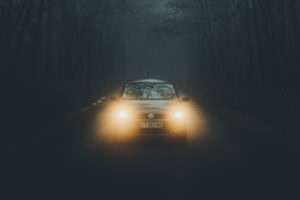If you are like any of the hundreds of thousands of people who haven’t had the chance to drive through dense fog, you are also probably wondering how fog lights work to help you in near-zero visibility fog conditions. After all, they are still “lights,” right?
Don’t worry. Most car owners don’t know how fog lights work or how they can help you up until they experience their first foggy drive. We’ll break down what makes fog lights work and how they can keep you safe during dreary conditions.
What are fog lights?
 Fog lights, or fog lamps, are a unique set of lights installed in cars with the specific purpose of helping out the driver in situations with reduced visibility. They can often be found below the headlights (how low depends on the car model).
Fog lights, or fog lamps, are a unique set of lights installed in cars with the specific purpose of helping out the driver in situations with reduced visibility. They can often be found below the headlights (how low depends on the car model).
A fog light can be identified by its bar shape and the sharp angle of illumination. Most of the time, they are rectangular or bar-shaped and give off a selective yellow light.
The fog light in your car differs from your regular headlights in their position and orientation. Your high beam and low beam are aimed at shallower angles to illuminate the road ahead. A fog light, in contrast, is aimed at a very sharp angle to the point where it illuminates what is directly in front of the vehicle.
People have this notion that all lights that are colored yellow are fog lights. This is not true as many older cars use selective yellow lights on their headlights as it is less likely to glare for other drivers.
Due to the orientation and angle of regular fog lights, they are unnecessary to use in normal driving conditions. While most people think it’s just better to light up everything in front of your vehicle while driving, using your fog light on a routine drive tends to make your eyes dilate due to having more light than usual in front of you. As a result, it will be harder for you to see a darker road in front of you.
How fog lights work to help you drive in poor driving conditions
 As the name suggests, fog lights are used during foggy weather or weather that offers poor to zero visibility. If you’ve had the chance to drive under heavy rain or fog, your regular headlights often provide little to no help improving your vision. In some cases, the setup of your headlights can even cause glare to the driver, making it much more dangerous. This is because the light being given off by your headlight gets bounced off (or back to you) in fog, making them useless.
As the name suggests, fog lights are used during foggy weather or weather that offers poor to zero visibility. If you’ve had the chance to drive under heavy rain or fog, your regular headlights often provide little to no help improving your vision. In some cases, the setup of your headlights can even cause glare to the driver, making it much more dangerous. This is because the light being given off by your headlight gets bounced off (or back to you) in fog, making them useless.
Fog lights, on the other hand, illuminate the ground just in front of your car. The selective yellow light and the angle make it less likely to bounce off or back to you in heavy rain or fog. In moments when your high or low beam makes it harder for you to see what’s in front of you, it is better to switch to your fog lights.
Just a word of caution, though. Fog lights only provide illumination on what’s directly in front of your vehicle. This means you should be going at a relatively slower speed for the fog light to help you out. Traveling at high speeds in poor visibility conditions with only your fog lights can cause accidents.
Your One-Stop Solution For Auto Repairs
If you are in Atlanta and you are looking for a trusted name to work on your Toyota, Nissan, Infiniti, or Lexus, then you can give T3 Atlanta a call right away. We specialize in providing affordable and quality service to all customers who go through our doors.
With 23 years of experience in the industry, you can rest assured knowing you are in good (if oil-greased) hands with T3 Atlanta!










Leave a Reply
You must be logged in to post a comment.